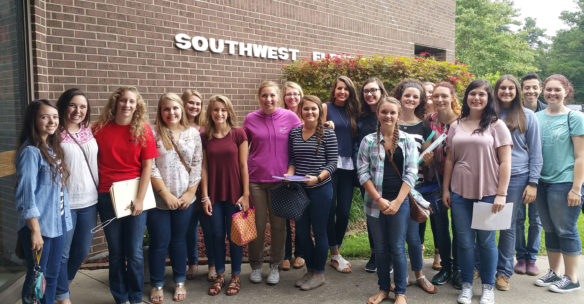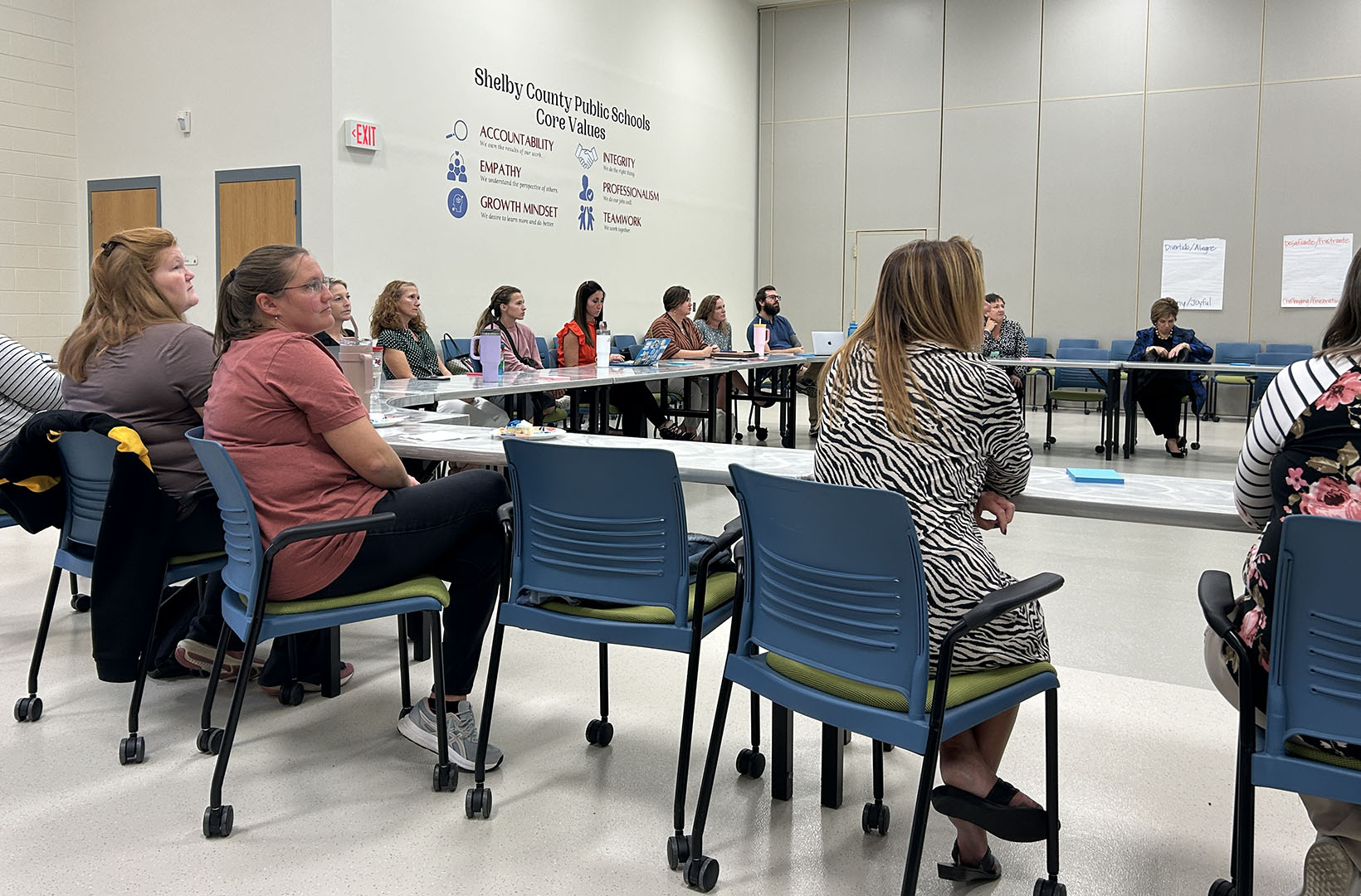
Students at Calloway County High School are participating in a new class called Español para Adolescentes, during which they help teach foreign language classes at elementary schools in the district. Students visiting Southwest Calloway Elementary School include, from left, Emily Wilson, Jordyn Wyatt, Hannah Anderson, Avery Wilmurth, Libby Scott, Madison Phillips, Mallory Hlava, Sierra Todd, Liz McClain, Taylor Smith, Madison Betts-Evans, Hailey Watson, Alyssa Sullivan, Makayla Wadkins, Cheyenne Kimball, Hannah Boren, Kayleigh Burch, Bryce Peal and Lauren Hale.
Submitted photo by Sarah Loveless
By Sarah Loveless
sarah.loveless@calloway.kyschools.us
In Murray, students at Calloway County High School are breaking new ground in language teaching.
For the 2016-17 school year, high school students enrolled in a new elective, Español Para Adolescentes, in order to help with the need for world languages in Calloway’s elementary schools. Students that were eligible to take this class were strongly encouraged to enroll because they were at the top of their classes in Spanish. To qualify, they had to exhibit a proficiency of intermediate low or better according to the American Council on the Teaching of Foreign Languages Proficiency scale.
As language educators, we know there is a vital need to begin language learning at an early age. With Español Para Adolescentes, we are able to meet a need at the elementary level while allowing high school students to explore a teaching career path and earn dual credit – Calloway County High School elective credit and Murray State University general education credit. My hope is to share how this program started so other districts can create similar programs to meet the same need.
Keep communication lines open
First, talk to your superintendent and administration at all levels. Keep all parties informed. Emphasize the need for world languages and global competencies to be taught at all levels both for student gain and accountability purposes. Sell your own high school program and the competency of your students in the target language.
Look for partnerships
Partner with a local university. Advocate for the high school students taking the class to be able to receive dual credit for their work teaching the elementary school students. I partnered with the Teacher Quality Institute (TQI) at Murray State University. Murray agreed to give the students a three hour credit for EDU 106 Peer Tutoring. The high school students had to enroll in the Racer Academy – a program for high school students to take college classes – in order to receive dual credit.
With the help of Kem Cothran and Cindy Thresher of the Teacher Quality Institute, my class received 10 Google Chromebooks from TQI for use for teaching and planning. I requested this type of technology because our elementary schools already use Chromebooks. Find out what kind of technology your district elementary schools use and ask for the same technology for your class. If you do not ask, you will not get it!
Advocate for the class
Talk to your school curriculum committee so your class can be proposed to your school-based decision making council. Sell your class by explaining that it will be providing a service districtwide. High school students will benefit by receiving college credit while elementary school students get to learn from excellent, teenage role models. The school district benefits by having world languages taught in the elementary schools, while high school world language programs benefit because students are getting language exposure years before entering high school.
Recruit the best
Set the bar high for the students you want in this class. My students had to have a score of intermediate low or better according to the American Council on the Teaching of Foreign Languages’ Proficiency Guidelines. Talk with the students who are potential candidates. Encourage them to make room in their schedules to take this elective and inform them of the dual credit option. Tell them why you believe they would be good candidates for the new class. Explain how they can have the opportunity to explore a career in education before they even get to college.
Think about transportation
Talk with your superintendent about funds for a driver and fuel. Consider getting your commercial driver’s license (CDL) to save money on the cost of a driver. Figure out how long it will take your class to travel to and from the locations they will visit. This will give you an idea of total time you will use for travel and teaching.
Consider scheduling
Pick an ideal time in your teaching schedule for the class and request that time slot in advance, if possible. We are on a 4 x 4 block schedule of 90-minute classes. I requested third block, because it gives us two hours for travel and teaching. Third block also runs into our 30-minute lunch.
We travel to the elementary schools, teach for one hour, eat lunch there and return to school in time for fourth block. We are gone from 11:30 a.m. to 1:30 p.m. A typical week looks like the following:
- Monday: Lab day – plan, reflect, guest speakers, etc.
- Tuesday: Lab day – plan, reflect, guest speakers, etc.
- Wednesday: Southwest Elementary School visit – Teach 1st- and 2nd grade
- Thursday: Calloway County Middle School visit – Peer tutoring English Language students
- Friday: North Elementary School visit – Teach 3rd grade
Select materials
Decide on a world language program to use or create your own. I started with Arte y Más, because it is an excellent, free program made available through PBS Learning Media and KET. All resources for this program are free too. The videos are 10 minutes long and they are all in the target language.
My students create lessons that reinforce what is introduced in the video. The lessons engage students and focus on speaking the language. They incorporate songs and games in every lesson. The elementary school students have learned colors, numbers, commands, school supplies, basic introductions and common questions.
Take a hard look at logistics
This is the most challenging aspect of the new program. Carving out time from the elementary school day that overlaps the time your class is taught is difficult. Talk to the elementary schools early so they can plan for this. Be flexible in who and how students teach. We do whatever fits into the elementary school’s schedule.
Remember, you are trying to get the program established the first year. It can be expanded in the years to come. Hopefully, you will have your own crop of language teachers breaking ground very soon.
Sarah Loveless is a Spanish teacher at Calloway County High School. She has a master’s in Spanish and secondary education and is National Board certified in world languages other than English. She currently serves as the Kentucky World Language Association’s Region 1 regional representative.




Leave A Comment